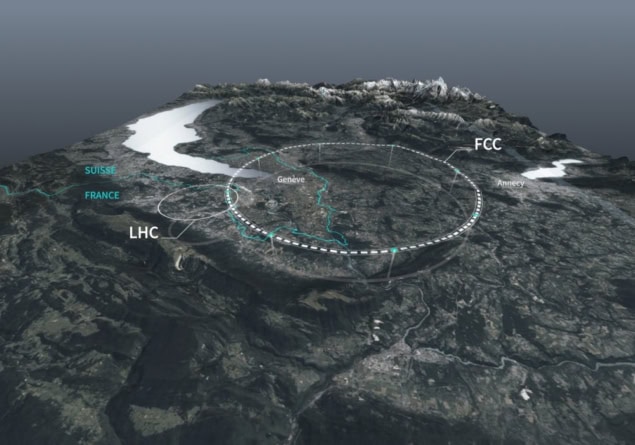CERN releases plans for the ‘most extraordinary instrument ever built’
 |
The CERN particle-physics lab near Geneva has released plans for the 15bn Swiss Francs (£13bn) Future Circular Collider (FCC), a huge 91 km circumference machine. The three-volume feasibility study, released on 31 March, calls for the giant accelerator to collide electrons with positrons to study the Higgs boson in unprecedented detail. If built, the FCC would replace the 27 km Large Hadron Collider (LHC), which will end in the early 2040s.
Work on the FCC feasibility study began in 2020, and the report examines the physics objectives, geology, civil engineering, technical infrastructure, and territorial and environmental impact. It also discusses the R&D needed for the accelerators and detectors, and the socioeconomic benefits and costs.
The study, involving some 150 institutes in over 30 countries, considered some 100 different scenarios for the collider before settling on a ring circumference of 90.7 km that would be built underground at an average depth of about 200 m.
The FCC would also contain eight surface sites to access the tunnel, seven in France, one in Switzerland, and four main detectors. “The design is such that there is minimal impact on the surface, but with the best possible physics output,” says FCC study leader Michael Benedikt.
The funding model for the FCC is still a work in progress, but it is estimated that at least two-thirds of the cost of building the FCC-ee will come from CERN’s 24 member states.
Four committees will review the feasibility study, beginning with CERN’s scientific committee in July. It will then go to a cost-review panel before being reviewed by the CERN council’s scientific and finance committees. In November, the CERN council will examine the proposal, with a decision to proceed in 2028.
If given the green light, construction on the FCC electron-positron machine, dubbed FCC-ee, would begin in 2030, and it would start operations in 2047, a few years after the High Luminosity LHC (HL-LHC) closes down, and run for about 15 years. It’s main aim would be to study the Higgs boson with a much better precision that the LHC. To the energy frontier: if built, the FCC-hh would begin operation in 2073 and run to the end of the century (courtesy: PIXELRISE)
To the energy frontier: if built, the FCC-hh would begin operation in 2073 and run to the end of the century (courtesy: PIXELRISE)
 To the energy frontier: if built, the FCC-hh would begin operation in 2073 and run to the end of the century (courtesy: PIXELRISE)
To the energy frontier: if built, the FCC-hh would begin operation in 2073 and run to the end of the century (courtesy: PIXELRISE)The FCC feasibility study then calls for a hadron machine, dubbed FCC-hh, to replace the FCC-ee in the 91 km tunnel. It would be a “discovery machine”, smashing together protons at high energy to create new particles. If built, the FCC-hh will begin operation in 2073 and run until the end of the century.
The original design energy for the FCC-hh was to reach 100 TeV, but that has now been reduced to 85 TeV. This is mostly due to the uncertainty in magnet technology. The HL-LHC will use 12 T superconducting quadrupole magnets made from niobium-tin (Nb3Sn) to squeeze the beams and boost the luminosity.
CERN engineers think it is possible to increase that to 14 T, and if this were used for the FCC, it would result in a collision centre-of-mass energy of about 85 TeV. “It’s a prudent approach at this stage,” noted Fabiola Gianotti, current CERN director-general, adding that the FCC would be “the most extraordinary instrument ever built.”
The original design called for high-temperature superconducting magnets, such as so-called ReBCO tapes, and CERN is investigating such technology. If it were to come to fruition in the necessary timescales and be implemented in the FCC-hh, it could push the energy to 120 TeV.
China plans
One potential spanner in the works is China’s plans for a similar machine called the Circular Electron-Positron Collider (CEPC). A decision on the CEPC could come this year with construction beginning in 2027.Read more

Yet officials at CERN are not concerned. They point to the fact that many different colliders have been built by CERN, which has the expertise and infrastructure to build such a giant collider. “Even if China goes ahead, I hope the decision is to compete,” says CERN council president Costas Fountas. “Just like Europe did with the LHC when the US started to build the [cancelled] Superconducting Super Collider.”
If the CERN council decides, however, not to proceed with the FCC, Gianotti says that other designs to replace the LHC, such as a linear machine or a demonstrator muon collider, are still on the table.
from physicsworld.com 2/5/2025
Δεν υπάρχουν σχόλια:
Δημοσίευση σχολίου